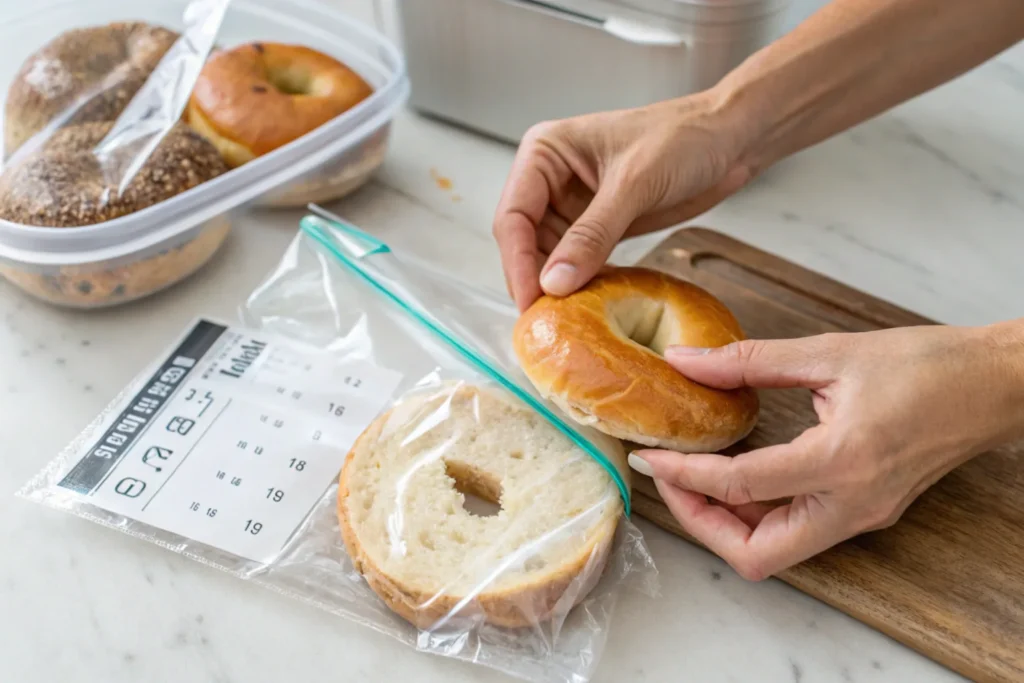There’s nothing quite like the first bite into a freshly baked sourdough bagel chewy crust, tangy flavor, and that soft, tender crumb inside. But here’s the thing: unless you’re planning to eat the whole batch in a single sitting (and honestly, I wouldn’t blame you), you’re going to need to store them. Storing sourdough bagels might sound simple, but one wrong move and you’re dealing with rock-hard crusts, soggy bottoms, or worse moldy disasters. I’ve been there. And after years of baking, testing, and yes, rescuing more than a few stale bagels, I’m sharing everything I’ve learned so you can do it right from the start.
A Little Story from My Kitchen
I’m Megan. If you had told little me that one day I’d be writing about bagel storage, I probably would’ve giggled. Some of my earliest memories are wrapped in the scent of rising dough and the soft crackle of crust cooling on a wire rack.
My grandmother always said, “Bread talks to you if you listen close enough.” Watching her let loaves cool “just long enough,” wrapping each one like a treasure it wasn’t just baking. It was care. And that same care is what I put into this guide. So let’s get into it because storing your sourdough bagels shouldn’t feel like guesswork. It should feel like part of the love you baked into every bite.

Why Learning How to Store Sourdough Bagels Changes Everything
You’ve made a beautiful batch of sourdough bagels. You nailed the rise (and if you didn’t, here’s how to master the perfect bake). The crust has that golden crisp, the center is soft and slightly tangy and you’re proud. Now what?
If you’re just tossing them in a plastic bag or leaving them on the counter uncovered, you’re not just shortening their shelf life. You’re compromising everything that makes them magical.
Knowing how to store sourdough bagels properly ensures they stay just as fresh as the moment they came out of the oven.
Why Sourdough Bagels Need Special Storage Care
Sourdough bagels are made with a natural fermentation process using a wild yeast starter. This gives them:
- A complex flavor profile (tangy, deep, slightly earthy)
- A crust that’s thicker and chewier
- A more sensitive structure that dries out or softens faster if not stored properly
Compared to yeast-raised bagels, sourdough has no commercial preservatives, which means they’re more prone to moisture changes, staleness, and even mold if you don’t store them with care.
You can read more about this difference in Sourdough vs. Regular Bagels, where I break down texture, taste, and health impact.
How the Fermentation Process Affects Shelf Life
That slow fermentation process makes sourdough naturally more resistant to mold but only up to a point. Once sliced or exposed to air, the clock starts ticking. Within 24–48 hours, even the best batch can go stale, chewy, or weirdly damp if left on your countertop unwrapped.
Proper storage means locking in:
- Flavor: So you still get that signature sour tang.
- Texture: So your crust stays crispy, not soggy.
- Freshness: So you can enjoy your bagels for days, not just hours.
Mistakes People Make When Storing Sourdough Bagels
Let’s be real: you don’t spend hours crafting the perfect sourdough bagels recipe just to let them go stale the next day. Yet, so many people unknowingly ruin their bagels with simple storage missteps. Been there, done that. And the heartbreak is real.
Want to learn how to store sourdough bagels like a pro? I’ve laid out all your options. Here’s what I’ve learned the hard way and what you can sidestep with a few tweaks in your kitchen routine.
Why Moisture Is the Real Threat in Sourdough Bagel Storage
Moisture can be both friend and foe. When baking, you need it. When storing? Not so much.
Too much moisture = sogginess + mold.
When you wrap warm bagels or leave them in humid environments (like the top of the fridge or over the dishwasher), condensation builds up. That dreamy crust? Gone. That chewy center? A sticky mess.
To prevent this:
- Always let your bagels cool completely on a wire rack before storing.
- Never seal warm bagels in a plastic bag or container.
- Avoid placing bagels near warm appliances.
Pro Tip: My grandma used to slip a paper napkin inside the bag to absorb excess moisture. It sounds simple, but it works like a charm.
The Danger of Refrigerating Without Wrapping
Refrigeration is a hot debate in the baking world. Some swear by it, others avoid it like the plague. Here’s the truth:
The fridge doesn’t preserve bagels it dehydrates them.
That cold, dry air pulls moisture out of the dough, turning your once-perfect bagels into hockey pucks by day two. But sometimes (like during summer or in humid climates), refrigeration can help prevent mold. The key is wrapping them right.
If you must refrigerate, follow these steps:
- Wrap each bagel in plastic wrap or foil.
- Then place them in a zip-top bag or airtight container.
- Store in the back of the fridge where the temperature is more consistent.
Still, this method is best for 2–3 day storage max. Any longer? Freeze ’em instead. (More on that in the next section!)
Megan’s Tip: Storage Kills Crust Unless You Plan Ahead
One of the biggest mistakes I used to make? Storing bagels straight into a plastic bag, unwrapped, while they were still warm. It would always lead to that disappointing moment the next day when I’d reach in and find them mushy or hard. That’s when I started following my grandma’s rule:
“If you wouldn’t serve it to a guest, don’t seal it like garbage.”
Cool it, wrap it, protect it your bagels deserve better.
Curious about bagel texture changes? Head over to Are sourdough bagels supposed to rise? for insight on what affects rise, chew, and post-bake quality.

How to Store Sourdough Bagels
Ingredients
Method
- Let bagels cool completely after baking.
- For same-day eating, store in paper bags at room temperature.
- For 2–5 day storage, use airtight containers or plastic bags.
- For long-term storage, slice and wrap bagels individually, then freeze in labeled zip-top bags.
- Thaw at room temperature and toast to re-crisp.
- Optional: Microwave with a damp paper towel to restore softness.
Nutrition
Notes
Tried this recipe?
Let us know how it was!How to Store Sourdough Bagels for Short-Term Freshness
You’ve got a fresh batch of sourdough bagels cooling on the rack. You don’t want them to dry out. You don’t want them to go soggy. And you definitely don’t want mold. The good news? There’s a best method for every timeline.
From paper bags to freezer hacks, I’ve tested every trick on how to store sourdough bagels the right way. Whether you’re snacking tomorrow or storing for next month, I’ve got your back.
How to Store Sourdough Bagels for Short-Term Freshness
Paper vs Plastic:
If you’re planning to eat your bagels by breakfast tomorrow or the next day, you can keep them on the counter. But what you store them in makes all the difference.
Option 1: Paper Bag (Winner for Crust Lovers)
- Keeps your crust crispy and chewy
- Allows airflow to prevent condensation
- Doesn’t trap moisture (so no sogginess)
Just pop your cooled bagels into a paper bag, fold the top, and leave it on the counter away from heat or humidity.
But beware: after about 48 hours, bagels will start to harden.
Option 2: Plastic Bag (Best if You Like Soft Bagels)
- Traps moisture and keeps bagels softer
- Great if you’re planning to toast later
- Can lead to a slightly soggy crust
If you go this route, wrap each bagel in parchment paper first, then place in a plastic zip-top bag and push out excess air before sealing. This reduces the risk of crust collapse.
Related Post: Homemade Sourdough Bagels Recipe – Discover how I bake them chewy and bold, just like Grandma did.
How to Store Sourdough Bagels for Medium-Term Use
Plastic Bags vs Airtight Containers:
If you’re looking to stretch their life 3–5 days, you need something better than a paper bag.
Plastic Zip Bags (Most Popular)
✔ Keeps moisture in
✔ Easiest for everyday use
✖ May soften that crust you worked so hard on
Airtight Containers (Best for Texture)
✔ Holds structure better
✔ Keeps crust slightly more intact
✖ Needs more space in your kitchen
Here’s my go-to method:
- Wrap each bagel in parchment or wax paper
- Place into a reusable airtight container
- Store in a cool, dark cabinet or the back of your counter
How to store sourdough bagels isn’t one-size-fits-all it depends on how soon you plan to eat them.
Should You Refrigerate Sourdough Bagels? Let’s Settle It
Okay, let’s tackle this hot topic.
Refrigeration works… but only if done right.
It’s great for humid climates, mold prevention, or if your kitchen gets super warm. But the cold air dries out the bagels fast unless you seal them perfectly.
How to refrigerate the right way:
- Let bagels cool completely
- Wrap each in plastic or foil
- Seal in a zip-top bag
- Store away from the fridge door
Refrigerated bagels are good for up to 5 days, but you’ll definitely want to reheat or toast before serving.
Bonus: Sourdough Bread vs. Regular Bagels – Dive deeper into which ones store longer and why.
Quick Reference Flowchart: Choose Your Storage Strategy
Just Baked —>
↳ Eat Within 24–48 Hrs?
↳ YES: Use Paper Bag (for crust) or Plastic (for soft)
↳ NO:
↳ Eat Within 3–5 Days?
↳ YES: Airtight Container or Fridge (sealed)
↳ NO:
↳ Freeze Bagels (slice, wrap, seal, date)
Mistake to Avoid:
Don’t Slice Bagels Before You Cool Them
I’ve made this mistake too many times. Slicing hot bagels lets steam escape, dries the inside, and ruins structure. Always let them cool fully minimum one hour before slicing or wrapping.
Related Post: High Protein Cottage Cheese Bagels – This variation stores beautifully and makes meal prep a breeze!

How to Store Sourdough Bagels in the Freezer Like a Pro
Let’s face it unless you’re baking for a crowd or have bagel-obsessed teens at home, you won’t eat the whole batch in one go. And trust me, there’s no shame in freezing. In fact, freezing is the best long-term storage method if you do it the right way.
Why Freezing Works Best for Homemade Bagels
Sourdough bagels don’t have preservatives like the store-bought stuff. So even with airtight storage, they’re only good for a few days at room temp. Freezing hits pause on staling, mold, and moisture loss all while locking in flavor.
Unlike refrigeration (which dries them out), freezing preserves the bagel’s:
- Crust integrity
- Tangy sourdough flavor
- Moist interior
Want proof? I’ve pulled frozen bagels from the back of my freezer a month later, reheated them right, and served them to guests no one knew the difference.

Step-by-Step: How to Freeze Bagels Without Ruining Texture
Here’s the exact method I follow every time, learned from trial, error, and a few tear-worthy crust fails:
- Cool Completely
Don’t rush this. Warm bagels trap condensation that leads to freezer burn. Give them a full hour on a cooling rack. - Slice Before Freezing
Trying to cut a frozen bagel is like sawing a rock. Slice each one in half once cooled. This makes for super easy toasting straight from frozen. - Wrap Individually
Use one of the following:- Parchment or wax paper (preferred)
- Plastic wrap
- Foil (for extra protection)
- Bag It Up
Place wrapped halves into a large freezer-safe zip-top bag. Press out as much air as possible before sealing. - Label & Date
You will forget how long they’ve been in there. Label the bag with the date, flavor (if you have multiples), and slice info.
Stored this way, sourdough bagels will last up to 3 months without sacrificing quality.
How Long Do Frozen Sourdough Bagels Last?
Here’s your cheat sheet:
| Storage Method | Texture Holds For | Best Used By |
|---|---|---|
| Room Temp (paper bag) | 1–2 days | Within 48 hrs |
| Airtight Container | 3–4 days | Within 5 days |
| Fridge (sealed) | 5 days max | Toast before serving |
| Freezer (sliced & wrapped) | 3 months | Within 90 days |
Reheating Frozen Bagels Without Losing That Crust
Many readers ask me how to store sourdough bagels to prevent mold, especially during summer. Frozen doesn’t have to mean flat. Done right, they’ll taste like they just came out of the oven. Here’s how:
Option 1: Direct Toast
- Pop frozen, sliced bagel halves directly into your toaster or toaster oven.
- Toast on medium-high until golden and heated through.
- Perfect for mornings when you’re in a rush.
Option 2: Steam + Oven (My Grandma’s Hack)
This one brings back both softness and crunch:
- Wrap the frozen bagel in a damp paper towel
- Microwave for 15–20 seconds (to add moisture)
- Finish in the oven at 375°F for 3–5 minutes to restore crust
Grandma used to say, “A splash of steam and a blast of heat makes anything whole again.” It never failed.
Option 3: Thaw Overnight + Reheat
- Remove from freezer and thaw on the counter for 4–6 hours.
- Toast or warm in oven as desired.
Avoid: Microwaving too long or skipping the toast this leads to rubbery or soggy bagels.
Related Post: Protein Bagel Recipe These freeze exceptionally well and reheat like a dream.
How to Keep Sourdough Bagels Fresh Without Freezing
You might not always want to freeze your bagels. Maybe you’re planning to serve them over a long weekend, or you just prefer them at room temp. Freezing works great but what if we could keep that fresh-from-the-oven taste without relying on the freezer?
You absolutely can. And I’ve tested every trick in the book to bring you the non-freezer playbook.
Smart Tips to Prevent Staleness Naturally
Here’s how to keep your bagels fresh, crusty, and chewy without freezing, and without sacrificing texture:
Tip 1: Store in a Paper Bag, Then a Plastic Bag
Wrap your cooled bagels in parchment or a paper bag, then slip them into a loosely sealed plastic bag. This combo lets your bagels breathe just enough while retaining moisture.
Tip 2: Use Bread Boxes or Cloth Bread Bags
Yes, they still work! These old-school solutions allow airflow and keep the crust from going soft. Bonus: they look cute on your counter.
Tip 3: Store Bagels in Halves
Halving bagels before storage reduces the chance of stale cores (especially in thick sourdough styles). Just be sure to wrap each half individually.
Tip 4: Keep Away from Heat & Moisture
Store your bagels in a cool, dry cabinet or pantry never near your stove, oven, or dishwasher. Humidity and warmth = mold town.
Related Post: Homemade Sourdough Bagels Recipe Discover how I bake them chewy and bold, just like Grandma did.
Storage Flowchart: What to Do Based on Your Schedule
Sometimes it’s not about what you want it’s about what you’ve got time for. Here’s a quick decision flowchart to guide your bagel storage based on your schedule:
Just Baked Bagels →
↳ Need them today or tomorrow?
↳ YES → Store in paper bag or bread box at room temp
↳ NO →
↳ Need them in next 3–5 days?
↳ YES → Use airtight container or plastic bag in cool cabinet
↳ NO →
↳ Store in freezer (sliced + wrapped) for long-term
This method lets you plan your storage with purpose and protect that perfect crust you worked so hard to bake.

When All Else Fails: How to Save a Stale Sourdough Bagels
We’ve all been there. You reach for your last sourdough bagel only to find it’s hard enough to knock on wood. Don’t toss it. Stale doesn’t mean trash it means transformation.
Here are the easiest ways to breathe life back into a tired bagel (plus a few sneaky ways to turn leftovers into the MVP of your next meal).
Microwave Rescue Trick (with Moist Paper Towel)
This one’s great if you’re in a rush and need soft results fast:
- Wrap the stale bagel in a damp (not soaked) paper towel.
- Microwave for 15–20 seconds.
- Toast it lightly for crunch if desired.
Pro Tip: This works best if the bagel hasn’t gone rock hard but is just a bit dry. It reactivates moisture without overcooking.
Oven Steam Revive Method (Best for Crust & Chew)
If your bagel’s crust feels like it could double as armor, try this:
- Run the whole bagel quickly under running water yes man, water!
- Place directly on the oven rack at 375°F for 7–10 minutes.
- Remove when the crust is crisp and the inside feels soft to the touch.
Steam works wonders. It softens the crumb and crisps the crust like it’s bakery-fresh again.
Genius Ways to Use Stale Sourdough Bagels (Don’t Toss ‘Em!)
Sometimes, rescue isn’t enough. But stale bagels still have a second life and oh, is it delicious.
Turn Them Into Bagel Chips or Savory Croutons
This is a personal favorite (and a huge hit at parties).
For Chips:
- Slice bagels thinly into rounds.
- Brush with olive oil and season (garlic, sea salt, chili flakes, etc.)
- Bake at 350°F for 12–15 minutes until golden and crisp.
Serve with dips, hummus, or even as a crunchy salad topper.
For Croutons:
- Cube stale bagels into chunks.
- Toss with olive oil, herbs, and a pinch of salt.
- Bake at 375°F for 10–12 minutes.
Use in Caesar salad, on top of creamy soups, or just for snacking.
Make a Bagel Bread Pudding (Sweet or Savory)
Bagel bread pudding is ridiculously comforting. Here’s how I turn sad leftovers into a crowd-pleasing dish:
Sweet Version:
- Cube bagels and soak in a custard mix (eggs, milk, sugar, vanilla, cinnamon)
- Add chocolate chips, raisins, or even a swirl of jam
- Bake until golden and puffed
Savory Version:
- Mix bagel cubes with sautéed onions, spinach, or cooked turkey
- Add grated cheese, whisked eggs, and herbs
- Bake until set for a hearty brunch casserole
Bonus tip: Use homemade white bread to mix textures with your bagels for extra contrast.
Comparison Table: Which Storage Method Works Best?
Sometimes, you just want a quick glance at your best option no fluff, no guesswork. That’s exactly why I put together this easy-to-follow table. Whether you’re prepping for tomorrow’s breakfast or storing leftovers for the next few weeks, this will help you choose the right method for the right moment.
Table: Duration vs. Texture vs. Convenience
Here’s how each method stacks up when it comes to freshness, flavor, ease of prep, and overall bagel bliss:
| Storage Method | Best For | Texture Maintained | Max Duration | Ease of Use |
|---|---|---|---|---|
| Paper Bag | Crust lovers, 1–2 days | ✔ Crispy crust stays intact | 2 days | Super easy |
| Plastic Bag | Soft bagel texture lovers | ✖ Crust softens over time | 3–4 days | Very easy |
| Airtight Container | Maintaining crust & shape | ✔ Good crust retention | 3–5 days | Moderate effort |
| Refrigerator | Humid climates, mold prevention | ✖ Can dry out quickly | 5 days | Easy if wrapped properly |
| Freezer (Sliced & Wrapped) | Long-term storage | ✔ Excellent when reheated | Up to 3 months | Moderate prep, long payoff |
Megan’s Real Talk: From Stale to Stunning
The first time I made bagel chips, I was 14. I had forgotten an entire batch on the counter, uncovered. My grandma didn’t scold me she handed me olive oil and a baking sheet. “Nothing’s wasted in this kitchen,” she said.
That day, I learned bagels weren’t just for breakfast. They were ingredients waiting for a second chance.
Serving Suggestions: Make It a Meal
You’ve done all the work to store your sourdough bagels perfectly now it’s time to make them shine. Whether you’re whipping up breakfast for one or feeding a brunch crowd, these serving ideas will turn every bagel moment into a standout bite.
Bagel Sandwiches You’ll Love
When it comes to sourdough bagel sandwiches, the options are endless but these combos never fail me. I learned from my grandma that a well-layered sandwich isn’t just a meal. It’s a memory waiting to happen.
Savory Stack: Turkey, Avocado & Pesto
- Toasted sourdough bagel
- Roasted turkey breast (instead of pork)
- Fresh avocado slices
- Basil pesto or Greek yogurt spread
- Arugula and thin red onions
Perfect for lunch or a power-packed picnic.
Vegetarian Delight: Roasted Veggie & Hummus
- Garlic-roasted eggplant & red peppers
- Creamy hummus
- Sliced cucumber
- Sprouts or spinach
- Dash of smoked paprika
So satisfying you won’t miss the meat.
Morning Fuel: Scrambled Egg & Spinach Melt
- Scrambled eggs
- Sauteed spinach
- Turkey bacon (remember, no pork!)
- A slice of sharp cheddar
- Warmed on a skillet or panini press
This one’s a favorite from my weekend family brunches especially when made with Protein Bagels for a little extra fuel.
Breakfast Boards to Brag About
Brunch boards are trending for a reason. They’re stunning, customizable, and oh-so-shareable. Here’s what I build mine with (and always get rave reviews):
Build-Your-Own Bagel Board:
- Halved sourdough bagels (plain, seeded, everything)
- Sliced tomatoes, cucumbers, and red onions
- Whipped cream cheese (plain, herb, spicy)
- Turkey slices or smoked salmon
- Capers, pickled veggies, lemon wedges
- Mini jars of honey, jam, and Dijon mustard
Pro tip: Toast bagel halves lightly, then arrange them in a fan shape around the edge of your board.
Related: Sourdough bread vs. Regular Bagels – Why sourdough holds up better on boards with wet toppings.
Megan’s Family Favorite:
My grandma used to lay out what she called a “lazy breakfast platter” on Sundays: toasted bagel halves, soft scrambled eggs, and fresh fruit with a pot of tea. No frills just food from the heart.
That memory inspired my modern version: a board with sourdough bagels, turkey breakfast sausage, fresh strawberries, and a little jar of maple butter. Simple. Nostalgic. Perfect.
Final Thoughts: Store Smarter, Waste Less, Enjoy More
If there’s one thing I’ve learned after years in the kitchen guided by my grandma’s old-school wisdom it’s that every ingredient deserves respect. And sourdough bagels? They deserve proper storage, so you never waste a single bite.
Whether you’re team crust or team soft-and-chewy, you’ve now got the playbook to keep your bagels:
- Fresh longer
- Mold-free
- Full of that signature sourdough flavor
From short-term countertop tricks to freezer-saving secrets, every method in this guide helps you reduce food waste, save money, and stretch your baking efforts further. Plus, with reheating tips and creative uses for leftovers, not a crumb goes to waste.
I store my bagels with more confidence now and I hope you will too. After all, storing sourdough bagels isn’t just about food safety it’s about preserving what you worked hard to create.
Here’s to fewer dry bagels, more flavor-packed breakfasts, and kitchen habits that just make sense.
LET’S STAY CONNECTED! FOLLOW ME ON:
Tried this recipe? I’d be thrilled to see your take on it! Snap a pic and tag me @Sweftyrecipes so I can share your delicious creations with our foodie community.
→ FACEBOOK | INSTAGRAM | PINTEREST

Comments are closed.